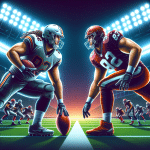The Zero-RB strategy, well-known among fantasy football enthusiasts, has been gaining popularity as a viable draft strategy that can potentially lead to significant success. With the considerable disparity in talent levels among running backs in recent years, many believe that prioritizing other positions before selecting running backs can be a strategic advantage. But what exactly is the Zero-RB strategy and how does it work?
The concept is pretty straightforward – fantasy owners opt to focus on positions other than running back during the early rounds of the draft. By bypassing running backs in the beginning, individuals have the opportunity to shore up their roster with top-tier talent at wide receiver, tight end, or quarterback. Considering the volatility of the running back position and the frequent turnover due to injuries or unexpected breakouts, adherents of this strategy often rely on the waiver wire to supplement their running back depth throughout the season.
When implementing the Zero-RB strategy, there are different degrees of aggressiveness that can be employed. Some owners may lean heavily on elite wide receivers like Amon-Ra St. Brown, Puka Nacua, or Davante Adams before selecting any running backs. Others might opt for a more balanced approach, mixing in tight ends or even quarterbacks in the early rounds.
As with any drafting strategy, the effectiveness of the Zero-RB approach can vary based on the specific dynamics of each fantasy league. Leagues that feature a superflex format with the option to start two quarterbacks might warrant an early investment in signal-callers. Smaller leagues with fewer teams could also be conducive to the Zero-RB strategy since the overall talent pool at other positions is not as diluted.
While running backs remain pivotal to fantasy success, the Zero-RB strategy hinges on the ability of quarterbacks, wide receivers, and tight ends to compensate for the potential lack of production from running backs. In scenarios where opponents roster multiple elite running backs like Derrick Henry and Kenneth Walker III, owners employing the Zero-RB strategy may need to rely on a collective effort from their other skill positions to make up the difference.
To maximize the chances of success with the Zero-RB strategy, it is imperative to make shrewd selections with early picks. Larger leagues or those with deep benches may pose challenges for owners using this strategy, as the pool of available running backs diminishes rapidly. Even a conservative approach can be daunting in leagues that allow for extensive bench spots.
In the quest to gain a competitive edge and think outside the box during the draft, the Zero-RB strategy has garnered increased interest among fantasy football enthusiasts. Drawing from mock draft experiences, a more cautious approach seems to yield better results. Setting a firm rule to abstain from selecting running backs in the first few rounds and closely monitoring the running back landscape as the draft progresses can help owners navigate the challenges of the Zero-RB strategy effectively.






